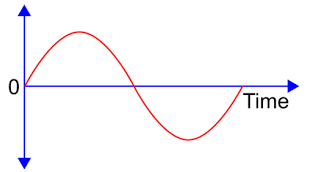This set of Basic Electrical Engineering Multiple Choice Questions & Answers (MCQs) focuses on “Alternating Current in an RLC Circuit”.
1. Find the total voltage applied in a series RLC circuit when i=3mA, VL=30V, VC=18V and R=1000 ohms. Note that it’s an AC circuit.
a) 3.95V
b) 12.37V
c) 32.67V
d) 6.67V
View Answer
Explanation: In an alternating current series RLC circuit, the total voltage VTotal applied is the phasor sum of the voltage drops across the resistor (VR), inductor (VL), and capacitor (Vc).
VR = 1000 * 3 * 10-3 = 3V.
\(V_{Total} = \sqrt{V_R^2 + (V_L – V_C)^2}\)
\(V_{Total} = \sqrt{3^2 + (30 – 18)^2}\)
\(V_{Total} = 12.37V\)
2. In an RLC circuit, which of the following is always used as a vector reference?
a) Voltage
b) Resistance
c) Impedance
d) Current
View Answer
Explanation: In an RLC circuit, the voltage is always used as a reference and according to the phase of the voltage, the phase of the other parameters is decided.
3. In an RLC circuit, the power factor is always ____________
a) Positive
b) Negative
c) Depends on the circuit
d) Zero
View Answer
Explanation: In an RLC series circuit, the power factor depends on the number of resistors and inductors in the circuit, hence it depends on the circuit.
4. In an RLC series phasor, we start drawing the phasor from which quantity?
a) Voltage
b) Resistance
c) Impedance
d) Current
View Answer
Explanation: In an RLC series phasor diagram, we start drawing the phasor from the quantity which is common to all three components, that is the current.
5. What is the correct expression for the phase angle in an RLC series circuit?
a) φ=tan-1(XL-XC)/R
b) φ=tan-1 (XL+XC)/R
c) φ=tan(XL-XC)/R
d) φ=tan-1 (XL-XC)
View Answer
Explanation: from the impedance triangle we get tanφ=(XL-XC)/R.
Hence φ=tan-1 (XL-XC)/R.
6. When is tanφ positive?
a) When inductive reactance is less than capacitive reactance
b) When inductive reactance is greater than capacitive reactance
c) When inductive reactance is equal to capacitive reactance
d) When inductive reactance is zero
View Answer
Explanation: tanφ is positive when inductive reactance is greater than capacitive reactance because current will lag the voltage.
7. When is tanφ negative?
a) When inductive reactance is less than capacitive reactance
b) When inductive reactance is greater than capacitive reactance
c) When inductive reactance is equal to capacitive reactance
d) When inductive reactance is zero
View Answer
Explanation: tanφ is negative when inductive reactance is less than capacitive reactance because current will lead the voltage.
8. Which of the following is not ac waveform?
a) sinusoidal
b) square
c) constant
d) triangular
View Answer
Explanation: AC waveforms are those which periodically changes polarity with time. Sinusoidal wave, square wave, triangular wave change their polarity at regular intervals so they are ac wavefoms. Constant wave doesnot change its polarity so it is not an ac waveform.
9. What is not a frequency for ac current?
a) 50 Hz
b) 55 Hz
c) 0Hz
d) 60 Hz
View Answer
Explanation: DC current is a type of constant current so it has frequency of zero hertz. So, AC current can have rest other frequencies other than zero.
10. Which type of ac waveform is given in figure?

a) sinusoidal
b) triangular
c) square
d) complex waveform
View Answer
Explanation: The figure depicts ac waveform of sinusoidal nature changing its polarity after regular intervals sinusoidally.
Sanfoundry Global Education & Learning Series – Basic Electrical Engineering.
To practice all areas of Basic Electrical Engineering, here is complete set of 1000+ Multiple Choice Questions and Answers.
If you find a mistake in question / option / answer, kindly take a screenshot and email to [email protected]
